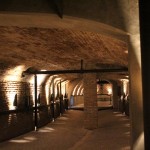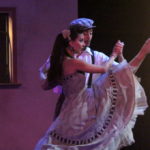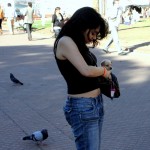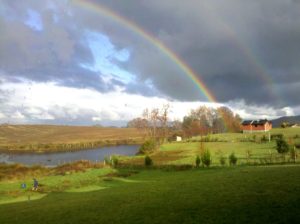We expected Buenos Aires to be cool and clammy –  but no, our stay has been lovely and sunny and comfortable for walking some of the shady parks and the rabbit warren of busy streets in the central part of this giant city. It was laid out with Parisian-wide boulevards, now clotted with traffic, and narrow streets, now often limited to walkers. Buenos Aires is more dressed up than the cities we have visited in Chile. Many people on the streets are tall, thin men in suits and tall, thin women in tights and high heels, as if ready for a tango at any minute. And
but no, our stay has been lovely and sunny and comfortable for walking some of the shady parks and the rabbit warren of busy streets in the central part of this giant city. It was laid out with Parisian-wide boulevards, now clotted with traffic, and narrow streets, now often limited to walkers. Buenos Aires is more dressed up than the cities we have visited in Chile. Many people on the streets are tall, thin men in suits and tall, thin women in tights and high heels, as if ready for a tango at any minute. And  the touts along the walking street of Av Florida certainly want to let you know that there is tangoing going on somewhere. Classical architecture, walking streets, tall people – sounds like
the touts along the walking street of Av Florida certainly want to let you know that there is tangoing going on somewhere. Classical architecture, walking streets, tall people – sounds like  Europe, and that is just where most of the Argentinians families came from. We are in the flat sea of the pampas, quite far from the mountainous Indian peoples of the north near Bolivia and Peru.
Europe, and that is just where most of the Argentinians families came from. We are in the flat sea of the pampas, quite far from the mountainous Indian peoples of the north near Bolivia and Peru.
 Buenos Aires seems to have worked hard to keep its classical architecture and integrate it
Buenos Aires seems to have worked hard to keep its classical architecture and integrate it  into the modern world. A great example is the Galarias Pacifico which is an 1889 building with ceiling murals done in the 1950’s and now restored to beauty. This is the beauty of the past and the ephemeral beauty of the present as represented by the rows of purveyors of elegant and expensive cosmetics and beauty treatments.
into the modern world. A great example is the Galarias Pacifico which is an 1889 building with ceiling murals done in the 1950’s and now restored to beauty. This is the beauty of the past and the ephemeral beauty of the present as represented by the rows of purveyors of elegant and expensive cosmetics and beauty treatments.
 Plaza de Mayo is a complex, open area surrounded by 19th century
Plaza de Mayo is a complex, open area surrounded by 19th century  buildings with the rose-colored presidential palace at one end. This square is the nation’s center for protest and for strolling with young children. Each day, mothers of some of the ‘disappeared’ come to continue their vigil in memory of their loved ones killed in 1976-1985 by Argentina’s ruthless right-wing military junta. The perpetrators are still free and today the vigil is continued with banners. Meanwhile, hoards of hand-holding preschoolers came with their teachers to point at buildings and to feed the pigeons in the park while people park their puppies in their purse.
buildings with the rose-colored presidential palace at one end. This square is the nation’s center for protest and for strolling with young children. Each day, mothers of some of the ‘disappeared’ come to continue their vigil in memory of their loved ones killed in 1976-1985 by Argentina’s ruthless right-wing military junta. The perpetrators are still free and today the vigil is continued with banners. Meanwhile, hoards of hand-holding preschoolers came with their teachers to point at buildings and to feed the pigeons in the park while people park their puppies in their purse.
We visited a number of the many museums in this  huge city. We saw bits of European history and lots of contemporary Latin American artists often painting the countryside in many different ways. An outstanding experience was a personal guided tour to a museum called “El Zanjon” which means “the ravine” in Spanish. The story of this museum is this: a rich fellow bought an ancient building in the part of the city that once was close to the port. He thought perhaps the neighborhood was changing and a restaurant or wine bar might be nice
huge city. We saw bits of European history and lots of contemporary Latin American artists often painting the countryside in many different ways. An outstanding experience was a personal guided tour to a museum called “El Zanjon” which means “the ravine” in Spanish. The story of this museum is this: a rich fellow bought an ancient building in the part of the city that once was close to the port. He thought perhaps the neighborhood was changing and a restaurant or wine bar might be nice  here. He tried to build a kitchen and found that the floor would not support much weight. So, he looked under the floor and he found an entire subterranean world dating back to the 1600’s. This place has since become a
here. He tried to build a kitchen and found that the floor would not support much weight. So, he looked under the floor and he found an entire subterranean world dating back to the 1600’s. This place has since become a  center for urban archaeology and now showcases the multiple constructions layered one on each other. The lowest is an arched structure that once enclosed a wandering stream which supported the later buildings which in turn hid the stream and it was then forgotten.
center for urban archaeology and now showcases the multiple constructions layered one on each other. The lowest is an arched structure that once enclosed a wandering stream which supported the later buildings which in turn hid the stream and it was then forgotten.
 The saying goes, “Throw a stone in Argentina, and you’ll hit a mate drinker.” Evidence of drinking yerba mate, and sharing this strong green tea, is everywhere here in Buenos Aires, crossing lines of class and ethnicity. There is definitely a ritual to this drinking tradition, as our hostal receptionist showed us on our first day this vibrant city. She filled her mate gourd 2/3 full with the dried, chopped leaves (a relative of holly). This supply will be her stash for the day, and she will repeat the process of pouring the hot
The saying goes, “Throw a stone in Argentina, and you’ll hit a mate drinker.” Evidence of drinking yerba mate, and sharing this strong green tea, is everywhere here in Buenos Aires, crossing lines of class and ethnicity. There is definitely a ritual to this drinking tradition, as our hostal receptionist showed us on our first day this vibrant city. She filled her mate gourd 2/3 full with the dried, chopped leaves (a relative of holly). This supply will be her stash for the day, and she will repeat the process of pouring the hot  (but not boiling) water from her thermos over the leaves as many as 15 times. She used a metal straw with a filter at the end, called a bombilla, to sip the strong and somewhat bitter brew, although bamboo straws are also used. Then she offered her gourd to us, and we discovered that mate is definitely an acquired taste, but one which many South Americans have partaken of for centuries. We wonder if Starbucks here may have a new calling….
(but not boiling) water from her thermos over the leaves as many as 15 times. She used a metal straw with a filter at the end, called a bombilla, to sip the strong and somewhat bitter brew, although bamboo straws are also used. Then she offered her gourd to us, and we discovered that mate is definitely an acquired taste, but one which many South Americans have partaken of for centuries. We wonder if Starbucks here may have a new calling….
 The tango tradition is alive and well in Buenos Aires, as we discovered one night at 10 p.m. in a popular venue called Tango Porteno in the busy central district. We splurged and went to a musical tango show which was just that – a showy professional dance performance illustrating the amazing physical agility of the
The tango tradition is alive and well in Buenos Aires, as we discovered one night at 10 p.m. in a popular venue called Tango Porteno in the busy central district. We splurged and went to a musical tango show which was just that – a showy professional dance performance illustrating the amazing physical agility of the  dancers, combined with theatrics and showy costumes. They exhibited incredible speedy and coordinated leg moves, with women lifting their legs over their heads, doing splits and leaping into their partner’s arms, often with the precision of two sets of flashing legs. Partners moved miraculously as one, defining the perfection of the dance. There was comic relief with a single dancer acting as two, tangoing with her left arm, and dispelling the myth that it takes two to tango. Some of the dances achieved dramatic modern dance interpretations. Coupled with a fine Malbec wine from the Mendoza Valley, what could have been more magical?
dancers, combined with theatrics and showy costumes. They exhibited incredible speedy and coordinated leg moves, with women lifting their legs over their heads, doing splits and leaping into their partner’s arms, often with the precision of two sets of flashing legs. Partners moved miraculously as one, defining the perfection of the dance. There was comic relief with a single dancer acting as two, tangoing with her left arm, and dispelling the myth that it takes two to tango. Some of the dances achieved dramatic modern dance interpretations. Coupled with a fine Malbec wine from the Mendoza Valley, what could have been more magical?
So, we have tasted a bit of this vast and complicated city for about a week. Buenos Aires can be cosmopolitan in its fancier barrios, or it can be pretty nitty-gritty in some of its poorer ones. It has an eminently walk-able  central city, yet it’s quite inexpensive to take a taxi or bus to get to some of the more distant areas. The coffee and gelato are excellent, and so are the pizza and pasta, due to a large population of residents with Italian backgrounds. We haven’t tasted the famous Argentinian
central city, yet it’s quite inexpensive to take a taxi or bus to get to some of the more distant areas. The coffee and gelato are excellent, and so are the pizza and pasta, due to a large population of residents with Italian backgrounds. We haven’t tasted the famous Argentinian  beef due to our vegetarian leanings, but we certainly don’t feel slighted in terms of our culinary sampling. We’ve appreciated the sense of style and design that we’ve seen on the streets, in the shops and in the museums – further evidence of good taste in this urban cultural goldmine.
beef due to our vegetarian leanings, but we certainly don’t feel slighted in terms of our culinary sampling. We’ve appreciated the sense of style and design that we’ve seen on the streets, in the shops and in the museums – further evidence of good taste in this urban cultural goldmine.
[shashin type=”album” id=”38″ size=”small” crop=”n” columns=”max” caption=”y” order=”date” position=”center”]











